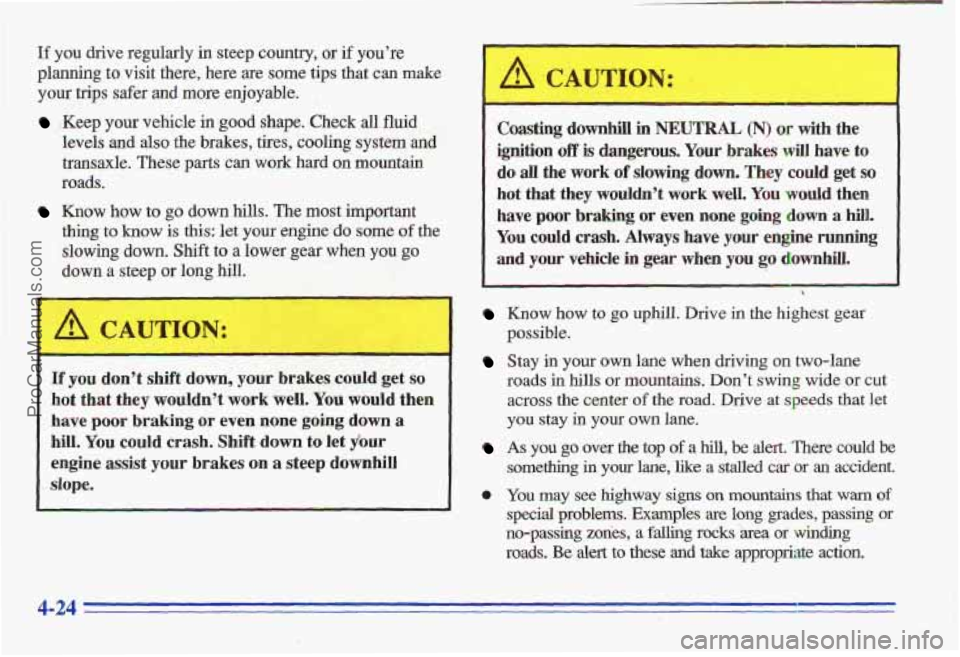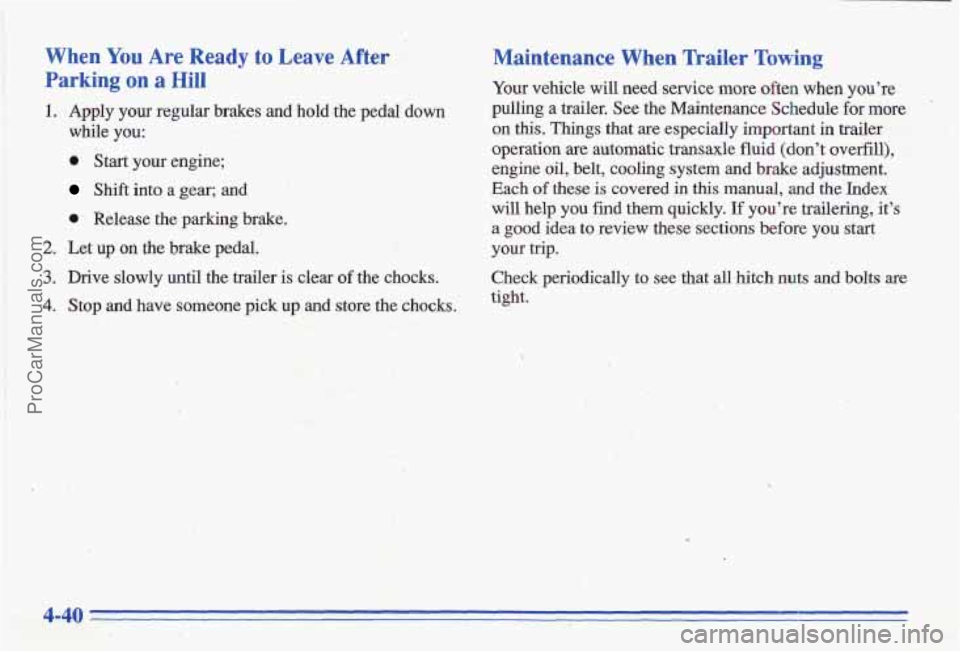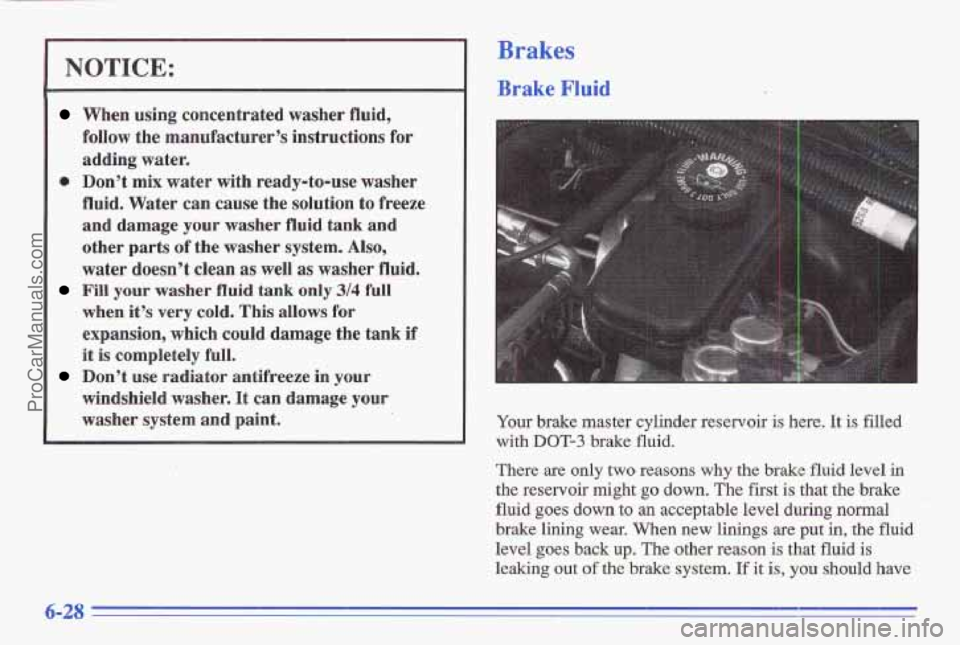Page 172 of 356

If you drive regularly in steep country, or if you’re
planning t’o visit there, here are some tips that can make
your trips safer and more enjoyable.
!Keep your vehicle in good shape. Check dl fluid
levels
and also the brakes, tires, cooling system and
transaxle.
These parts can work hard on mountain
roads.
Know Bow to go down hills. The most important
thing to know is this: let your engine do some of the
slowing down. Shift to a lower gear when you go
down a steep or long hill.
If you don’t shift down, your brakes could get so
hot that they wouldn’t work well. You would then
have poor braking
or even none going ddwn a
hill. You could crash. Shift down to let jour
engine assist
your brakes on a steep. downhill
.. slope.
Coasting downhill in NEUTRAL (N) or dvith the
ignition
off is dangerous. Your brakes will have to
do all the work of slowing down. They could get so
hot that they wouldn’t work well. You would then
haxe
poor braking or even none going down a hill.
You could crash. Always have your engine running
and your vehicle
in gear when you go downhill.
Know how to go uphill. Drive in the highest gear
possible.
Stay in your own lane when driving on two-lane
roads
in hills or mountains. Don’t swing wide or cut
across the center
of the road. Drive at speeds that let
you stay in your own lane.
As you go over the top of a hill, be alert. There could be
something in your lane, like a stalled car or an accident.
0 You may see highway signs on mountains that warn of
special problems. Examples are long grades, passing or
no-passing
zones, a falling rocks Area or winding
roads. Be alert to these and take appropriate action.
ProCarManuals.com
Page 188 of 356

When You Are Ready to Leave After
Parking on a Hill
1. Apply your regular brakes and hold,the pedal down
while
you:
0 Start your engine;
Shift into a gear; and
I. Release the parking brake.
2. Let up on the brake pedal..
3. Drive slowly until the trailer is clear of the chocks.
4. Stop and have someone pick up and store the chocks.
Maintenance When Trailer Towing
Your vehicle will need service more often when you're
pulling a trailer. See the Maintenance Schedule for more
on this. Things that are especially important in trailer
operation are automatic transaxle
fluid (don't ovel-fill),
engine oil, belt, cooling system and brake adjustment.
Each of these is covered in this manual, and the Index
will
help you find them quickly. If you're trailering, it's
a good idea to review these sections before you start
<* ~ I ,,; ;-':'. .a t , ,--: .. ;::l.$.:$ 5
Check periodically to see that all hitch nuts and bolts are
tight.
your trip. ! . .i . :$ ,,- .,,. . . f ~
_I.,
4-40
ProCarManuals.com
Page 228 of 356
NOTICE:
If you need a new cap, b'e sure to get the right
type.
Your dealer can get one for you. If you get
the wrong type, it may not fit or have proper
venting, and your fuel tank and emissions system
might be
damaged.
Things that burn can get on hot engine parts and
start
a fire. These include liquids like gasoline,
oil, coolant, brake fluid, windshield washer and
other fluids, and plastic
or rubber. You or others
could b'e burned. Be
careful not to drop or spill
things
that will burn onto a hot engine.
Checking "'lings Under the Hood
r
An electric fan under the hood can start up and
injure
you even when the engine is not running.
Keep hands, clothing and tools away from any
underhood electric
fan.
The following sections tell you how to check fluids,
lubricants and important parts underhood.
TO open the hood, first pull
the handle inside the
vehicle.
ProCarManuals.com
Page 230 of 356
2.4L (CODE T) Engine
When you open the hood, you’ll see:
Brake Fluid Reservoir
B. Engine Oil Fill Cap G. Windshield Washer Fluid Reservoir
C. Engine Oil Dipstick M. Hydraulic Clutch Fluid Reservoir (if so equipped)
D. Automatic Transaxle Dipstick (if equipped) I. Air Cleaner
E. Power Steering Fluid Reservoir J. Battery
6-8
ProCarManuals.com
Page 231 of 356
3.1L (CODE M) Engine
When you open the hood, ou’ll see:
A. Engine Coolant Surge Tank
B. Power Steering Fluid Reservoir
C. Engine Oil Fill Cap
D. Engine Oil Dipstick
E. Automatic Transaxle Fluid Dipstick
6-9
E Brake Fluid Reservoir
G. Windshield Washer Fluid Reservoir
H. Air Cleaner
I. Battery
ProCarManuals.com
Page 240 of 356
Checking the Fluid Level
' Park your vehicle on a level place. Keep the engine
running.
With the parking brake applied, place the shift lever
in
PARK (P). I
With your foot on the brake pedal, move the shift
lever through each
gear range, pausing for about
three seconds in each range. Then, position the shift
lever in PARK (P).
0 Let the engine run at idle for three to five minutes. Then,
without shutting
off the engine, follow these
steps:
1. The automatic transaxle dipstick handle is red. Pull
out the dipstick
and wipe it with a clean rag or paper
towel.
2. hsh it back in all the way, wait three seconds and
then pull it back out again.
6-18
ProCarManuals.com
Page 250 of 356

~~~
~~~~ NOTICE:
~ ~~~~ ~~~~~~~~~
When using concentrated washer fluid,
follow the manufacturer’s instructions for
adding water.
e Don’t mix water with ready-to-use washer’
fluid. Water can cause the solution to freeze
and damage your washer fluid tank and
other parts
of the washer system. Also,
water doesn’t clean
as well as washer fluid.
Fill your washer fluid tank only 3/4 full
when it’s very cold, This allows for
expansion, which could damage the tank
if
it is completely full.
windshield washer.
It can damage your
washer system and paint,
Don’t use radiator antifreeze in your
Brakes
Brake Fluid
Your brake master cylinder reservoir is here. It is filled
with
DOT-3 brake fluid.
There are only two reasons why the brake fluid level in
the reservoir might go down. The first is that the brake
fluid goes down to
an acceptable level during normal
brake lining wear. When new linings
are put in, the fluid
level goes
back up. The other reas’on is that fluid is
leaking out of the brake system, If it is, you should have
6-28
ProCarManuals.com
Page 251 of 356
your brake system fixed, since a leak means that sooner
or later your brakes won’t work well,
or won’t work
at
all.
So, it isn’t a good idea to “top off’ your brake fluid.
Adding brake fluid won’t correct
a leak. If you add fluid
when your linings are worn, then you’ll have too much
fluid when you get new brake linings. You should add
(or remove) brake fluid, as necessary, only when work is
done on the brake hydraulic system.
enough. You or others could be burned, and your
vehicle could be damaged. Add brake fluid only
when work is done on the brake hydraulic
When your brake fluid falls
to a low level, your brake
warning light will come
on.
See “Brake System Warning
Light”
in the Index.
~~
What to Add
When you do need brake fluid, use only DOT-3 brake
fluid
-- such as Delco Supreme 11 @ (GM Part
No. 1052535). Use new brake fluid from a sealed
container only,
and always clean the brake fluid
reservoir cap before removing
it.
ProCarManuals.com